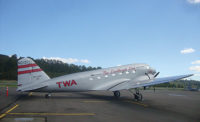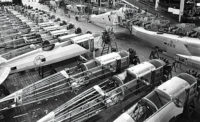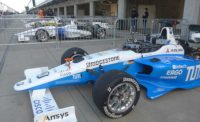When the first issue of ASSEMBLY rolled off the printing press in October 1958, the jet age was just beginning. Aerospace manufacturers were busy churning out bigger, faster, quicker and lighter products for a wide range of commercial and military applications.
In 1958, more than 1 million airline passengers flew across the Atlantic, for the first time surpassing the total of steamship passengers. Boeing had recently unveiled its revolutionary 707 jetliner. Meanwhile, Boeing’s biggest competitor, Douglas Aircraft Co., was building its own four-engine jetliner called the DC-8. Both aircraft transformed the airline industry and made flying faster, easier and more popular.
During the height of the Cold War, engineers at another Boeing legacy company based in Southern California, North American Aviation Inc., were busy developing a supersonic strategic bomber called the XB-70 Valkyrie. Only a few planes were built, but it pushed the envelope on aerospace design and manufacturing.
Meanwhile, engineers at McDonnell Aircraft Corp. in St. Louis were finetuning the legendary F-4 Phantom II. The company would go on to build more than 5,000 copies of the fighter for the U.S. Air Force, U.S. Marine Corps and U.S. Navy over the next two decades.
The United States was also embarking on space exploration when the first issue of ASSEMBLY, then known as Assembly & Fastener Engineering, was published. In fact, during the same month that the magazine debuted, the National Aeronautics and Space Administration (NASA) was created in response to Russia’s recent launch of a small satellite called Sputnik. That marked the beginning of the Space Race, an era in which billions of dollars were poured into developing new materials and advanced production processes.
During the last six decades, more than a dozen aircraft built by Boeing and its legacy companies have appeared on the cover of ASSEMBLY. The first product to earn the distinction was the 727 jetliner, which appeared on the magazine’s March 1964 cover. Boeing assembled the groundbreaking short-haul aircraft at its factory in Renton, WA.
727 Tri-Jet
The 727 used the same forward fuselage and cockpit section as the 707, but it was intended for use at smaller airports. The aircraft was distinguished by a high “T” tail, a 55-degree vertical fin, a selfcontained rear-entry stair, and three aft-mounted turbofan engines.
That design proved to be incredibly successful. The 727 eventually became the world’s best-selling jetliner, with more than 1,800 models built when production ended in 1984. (Its record has since been surpassed by the 737, which is assembled at Boeing’s Renton plant today.)
“The tail section could be called the heart of the 727,” proclaimed ASSEMBLY. “It must bear the weight and thrust of the three 14,000-poundthrust engines, besides incorporating vital control surfaces in its sweptback fin and topside horizontal stabilizer.
“The fin, made of aluminum, is nearly four feet thick where its forward point joins the fuselage,” added the magazine. “Below the fin, between the middle engine and the cabin, is a titanium fire wall.
“The 727s are being manufactured on two straight-line final assembly operations,” explained ASSEMBLY. “Production rate is one plane about every four working days, or five to six planes a month.”
An article in the October 1962 issue of Boeing magazine explained how the 727 was “blazing new manufacturing trails as it moves down the production line. There are a number of differences between this smallest and most versatile member of the Boeing jet family and its relatives.
“[An] important 727 production step is a new system of sink-lap bonding which improves pressuresealing of the airplane and adds to its fatigue life,” said the article. “Because the 727, designed for short flights, will take off and land more frequently than long-range jets, this bonding will provide an extra margin of safety and durability.
“The bonding adhesive, a type of fiberglass cloth which is damp to the touch, is applied at below-zero temperatures along the airplane’s longitudinal seams,” added the article. “After a 72-hour curing period, the adhesive strips become an integral part of the lap between the outer and inner skins of the aluminum body sections.”
A simpler wiring installation technique also made its debut with the 727. “Wire bundles which used to require separate-clamp buildups are now guided along well-defined raceways, which are connected by compact clamp stations,” noted the article. “These are easier to maintain. This new wire-run system, coupled with recent wire-bundle standardization practice, is cutting installation time.”
The 727 was the “middle child” in Boeing’s early jetliner family. (The 707 debuted in 1958 and the 747 was launched in 1969.) Although those two jetliners have received more accolades over the years, the humble 727 is credited with opening up air travel to millions of people.
“One airplane changed America by altering the definition of one day’s travel,” claims James Fallows, a longtime commentator for National Public Radio who wrote an essay on the plane for Defining a Nation (National Geographic Society).
“While the 727 was neither the first, nor the fastest, nor the safest, nor the highest-flying, nor the longest-range jet airliner of the 20th century, it was the one with the most historic impact,” Fallows points out. “It was the first to be simultaneously fast enough, affordable enough, safe enough and convenient enough to make air travel a routine rather than an exceptional part of American life.”
747 Super Jumbo
In the mid-1960s, Boeing built a new factory in Everett, WA, to assemble a plane that would have more than double the passenger capacity of any existing airliner. The 747 jumbo jet ushered in a new era of international air travel. The incentive for creating the plane came from reductions in airfares, a surge in air-passenger traffic and increasingly crowded skies.
The 747 appeared on the cover of ASSEMBLY in April 1969. It had just rolled off the assembly line at the largest factory in the world.
An article in the magazine explained how Boeing engineers used an automated wing panel riveting machine to build the 747. Each machine was 24 feet high, 18 feet wide and 22 feet long. Two operators monitored the assembly process.
“The machine consists of five numerically controlled, self-propelled riveting heads that travel on 300-foot rails,” explained ASSEMBLY. “The system is equipped with hydraulicelectrical turntables at one end of each set of tracks to enable any unit to make a 90-degree turn and move to another set of tracks.
“Each wing panel contains 16,000 fasteners,” added the article. “Normal operating speed calls for a rate of four fasteners per minute from each riveting unit. At peak production, the riveting heads will produce four wing panels every 2.5 days, enough for one complete airplane.
“Wing panels are temporarily fastened together and positioned horizontally on 10-foot-high vertical supports next to the rails,” said the article. “As the riveting units travel slowly past the panels, they automatically locate each rivet hole, drill and countersink, insert and squeeze the rivets, and microshave them flush to the wing surface. This squeezing causes the fasteners to expand in the hole, forming permanent fuel-tight joint wing ‘shells’ or panels for the upper and lower surfaces of the wings.
“The bulk of the wing panel fasteners used on the 747 are aluminum rivets,” ASSEMBLY pointed out. “However, different loads and stresses on the wings require several kinds and sizes of fasteners, all of which can be driven by the machine. For titanium taperedshank bolts, for example, the machine drills tapered holes.”
Almost 50 years later, production is still going strong at Boeing’s Everett plant, which now also assembles the 777 and the 787. In fact, the 747 recently became the first wide-body airplane in history to reach the 1,500 unit milestone.
DC-10 Wide Body
The McDonnell Douglas DC-10 appeared on the cover of ASSEMBLY twice (July 1970 and May 1973). It satisfied an untapped niche between the 707 and the 747 for an aircraft with a capacity in the 250 to 380 seat range.
In addition to its spacious interior, the three-engine aircraft incorporated numerous improvements in aerodynamics, avionics, environmental compatibility, flight control systems and propulsion. Two million fasteners were used to assemble the tri jet.
The DC-10 was assembled in Long Beach, CA. Between 1968 and 1990, McDonnell Douglas built more than 440 copies of the aircraft, including passenger and cargo variants, as well as the KC-10 aerial tanker for the U.S. Air Force.
“Using a modern approach to assembly, McDonnell Douglas is reducing production time,” proclaimed the July 1970 issue of ASSEMBLY. “The fuselage consists of four subassemblies that are fitted with wiring, plumbing, ducting, lights, insulation, ceiling and wall panels before they are joined together.
“This novel approach and the 19-foot diameter fuselages allow onepiece installation of king-size subassemblies through the open end of the cabin sections,” added the article. “Previously, the size of subassemblies was limited by the size of cabin doors.
“Some 3,000 pounds of tapered interference-fit fasteners of 6A1-4V titanium are used in each jetliner, including hundreds of lockbolts up to 5/8-inch diameter used to join the wings and fuselage,” explained ASSEMBLY. “The prestressed interference-fit fasteners reduce cyclic service stresses and improve fatigue life.”
Some other Boeing products to appear on the cover of ASSEMBLY over the years include:
- Douglas DC-9 (October 1966).
- Boeing Tucumcari hydrofoil (July 1973).
- Rockwell International Space Shuttle (January 1977).
- Boeing 777 (December 1994 and April 2015).
- Boeing 717 (August 2001).
- Boeing 737 (August 2005).
- Boeing 787 (August 2006).
- Boeing P-8A Poseidon (September 2008).








